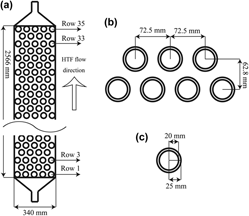Published online by Cambridge University Press: 05 January 2017

Metallic phase-change materials (PCMs) attract much attention due to their high thermal conductivity in thermal energy storage. Our previous work reported a kind of Cu@Cr@Ni bilayer capsules, which could endure at least 1000 thermal cycles between 1323 and 1423 K without leakage, and might be a potential high-temperature metallic PCM. This study numerically investigates the thermal energy charging performance of Cu@Cr@Ni capsules for recovering high-temperature waste heat at both constant and periodically fluctuant heat transfer fluid temperatures. It was revealed that only a short and slight sloped melting platform existed in the curve of outlet temperature due to the ultrahigh thermal conductivity of copper; with higher inlet velocities, the outlet and mean temperatures of such PCM increased and meanwhile the energy transfer efficiency decreased; the outlet and mean temperatures of the PCM and the liquid fraction in it were rather insensitive to the period of the inlet temperature fluctuation; and the amplitude of inlet temperature fluctuation, ±50 K, was sharply reduced to 5 K due to the thermal damping of the PCM.
Contributing Editor: Yanchun Zhou